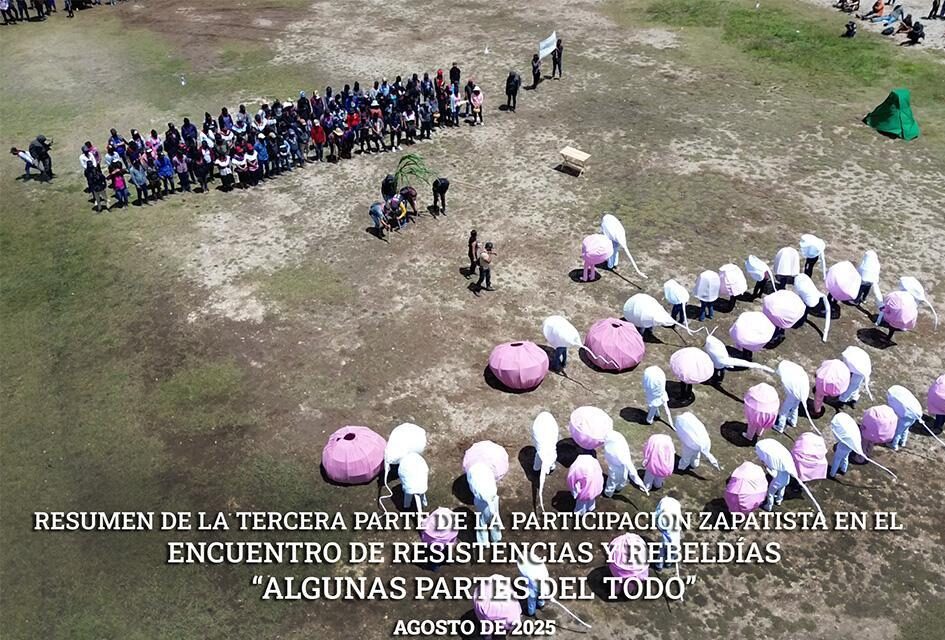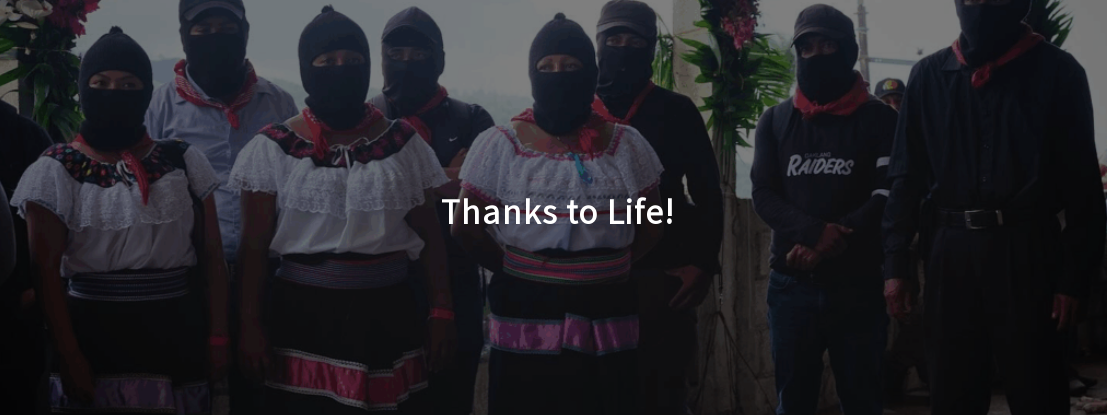
After attending a meeting with our dead (part one) and severely criticizing the functioning and structure of the autonomous governments (part two), the Zapatista communities begin to analyze the positive contributions of those early efforts. While they point out the progress made in collective work, education, health, and as women, among other advantages, the assembly receives an unexpected visitor: the future.
Thus begins a terrible and wonderful exchange between today and tomorrow.
A multitude of eggs and sperm, referred to as “agüitas (little waters)” in the play (don’t ask me why they were given that name), appear at the assembly and ask a series of questions. Not only about love and such things, although that too. Then the assembly explains what it’s all about.
They give as an example the making of tamales. They describe the preparation of the soil, the sowing, the harvesting, the grinding and cooking of the corn, and everything related to the preparation of the dough and the filling of the tamales. They explain that this takes time, that the tamale does not suddenly appear on the table, but that it takes time, effort, and work. They tell them that they are going to put the tamale on a mountain, and that it has taken and will take entire generations to get it there. That each generation is replaced by the next. In other words, they detail the parts of the whole. And that it will be up to those “aguitas” to discover and understand the task that falls to them. They recommend that they care for, love, and protect Mother Earth because she is life. Work with her and upon her, in common and without private property.
A Durito and a Durita remain as witnesses who will see that the waters fulfill their part in the struggle. In other words, nature remains as a witness.
What is the tamale made of? Well, as I understand it, that will be known in more than 100 years. So it’s “chili, sweets, and lard.”
Gossip: when the young people in the play acted out a couple’s argument, SubMoy told a coordinator that he didn’t remember that part from rehearsals. The coordinator replied that it wasn’t there, the actors improvised it on the spot… and it turned out very well.
From the mountains of southeastern Mexico.
The Captain
August 2025

Thanks to Life!
The protagonists were the support bases of the twelve caracoles, EZLN militiamen and women, who built the spaces in the Morelia seedbed that housed the delegations from Mexico and around the world, took care of the attendees, and staged plays that allowed us to understand more deeply the paths they will continue to follow in the coming years.
An extremely hopeful feature, although not new, was the overwhelming presence of young people, particularly among the militiamen and women and among those who performed in the plays. The plays deserve a separate comment. Not only did they create the scripts, sets, and costumes, some of which were truly remarkable, but they also had to be coordinated from the most diverse areas, which we believe involved months of extensive, intense work.
There was an opening ceremony held by militiamen in support of the Palestinian people, but there was no closing ceremony. Only a simple thank you from Sub Moisés to the attendees and the support bases. Without further ado, he closed the meeting to make way for poetry, music, and dancing, in which thousands of support bases and attendees from the most diverse geographies participated, as they did every night.
The sharing of experiences by delegates from movements and organizations from 45 countries took up most of the time, attended by the support bases while the militiamen followed from a distance. It was many hours of listening, that serene and attentive listening that the Zapatistas teach us with generous humility.
Moisés played a decisive role, even more noticeable because Captain Marcos did not speak. He participated in many discussions, contributing a refreshing and always unpredictable perspective, with simple examples from everyday life, infinite patience to make himself understood, and this time carrying a pipe that, who knows, seemed like a tribute to the captain, given his mannerisms, the way he smoked, and even the way he blew smoke into the air.
A large international and Mexican delegation visited the Dolores Hidalgo caracol, where the operating room donated by European solidarity is being built, along with a large hospital that is being built jointly by Zapatistas and non-Zapatistas. It will be a necessary project for the peoples of the region and a source of pride for the movement.
The last two days were spent answering questions from those attending the command post, one person from each caracol, half men and half women. In a single day, they spent more than four consecutive hours answering a wide variety of questions, some very interesting, others less so, but they always responded with good vibes and Zapatista humor.
The dining hall, El Común, was truly wonderful. There, Marijose and chef Ramón cooked delicious breakfasts, tacos, tortas, and other meals in a huge space where 80 Zapatistas worked in the kitchen or as waiters, 20 hours a day, maintaining good spirits and that spirit of dedication which, in itself, is much more than a revolutionary program.
Those of us who had the privilege of attending quickly forgot about the rain and mud to enjoy the space, the sharing, the informal conversations among attendees and, above all, with the Zapatista bases. They were wonderful days that we will cherish forever in our hearts.
Original text published in Desinformémonos on August 19th, 2025.
Translation by Schools for Chiapas.